PELAPORAN CORPORATE SOCIAL RESPONSIBILITY (CSR) UNIVERSITAS BERDASARKAN ANALISIS WEBSITE PADA NATIONAL UNIVERSITY OF SINGAPORE DAN UNIVERSITAS GADJAH MADA
 Abstract Views:
312 times
Abstract Views:
312 times
 PDF - FULL TEXT Downloads:
1554 times
PDF - FULL TEXT Downloads:
1554 times
Abstract
Abstrak
National University of Singapore dan Universitas Gadjah Mada termasuk dalam sepuluh universitas terbaik di Asia Tenggara (ASEAN). CSR menjadi sangat penting untuk universitas di ASEAN karena merupakan tujuan utama membangun komunitas ASEAN dalam bidang sosio-kultur atau yang disebut sebagai ASEAN Socio-Cultural Community (ASCC). Penelitian ini bertujuan untuk mengetahui penerapan tata cara pelaporan Corporate Social Responsibility (CSR) untuk National University of Singapore dan Universitas Gadjah Mada yang sebelumnya belum pernah dibuat dan dipublikasikan. Metode penelitian yang digunakan adalah content analysis untuk situs konten website, berita, artikel, annual report, dan informasi terkait CSR Universitas periode 2010-2014. Standar ISO 26000 digunakan sebagai alat pengukuran dan menjadi framework untuk membentuk sebuah laporan kegiatan CSR yang terintegrasi. Hasil dalam penelitian ini berupa kerangka laporan CSR dari kedua universitas.
Kata kunci: Pelaporan CSR Universitas, CSR Universitas, ISO 26000, ASEAN.
Abstract
Both the university is among the top ten best universities in Southeast Asia (ASEAN). CSR is very important for universities in ASEAN as an ultimate goal of establishing an ASEAN Community in the field of socio-culture, or the so-called ASEAN SocioCultural Community (ASCC). The purpose of this paper is to determine the application of the reporting procedures of Corporate Social Responsibility (CSR) for the National University of Singapore and the University of Gadjah Mada that has not previously been made and published. The method used is content analysis for website content sites, news, articles, annual reports, and information related to CSR University 2010-2014. ISO 26000 standard is used as a measurement tool and become a framework to establish an integrated CSR activity report. The findings of the study represent as CSR Reporting Framework for this universities.
Keywords: CSR Reporting for University, University – CSR, ISO 26000, ASEAN
Downloads
References
Christensen P, Thrane M, Jørgensen TH, dan Lehmann M. 2009. Sustainable development: assessing the gap between preaching and practice at Aalborg University. International Journal Sustainable Higher Education, 10(1): 4-20.
Dawkins. J. dan Stewart L. 2003. CSR in stakeholder expectations: and their implication for company strategy. Journal of Business Ethics, 44, p. 185.
Deegan C. 2002. The legitimising effect of social and environmental disclosures-A theoretical foundation. Accounting Auditing Accountability Journal, 15(3): 282-311.
Douglas, A., Doris, dan J., Johnson, B., 2004, Corporate Social Reporting in Irish Financial Institutions. Total Quality Management Magazine 16(6), 387-395
Elkington, J. 1997. Cannibals with Forks: The Triple Bottom Line of 21st Century Business. Capstone, Oxford.
Goodwin, F.W. dan Bartlett, J. L. 2008. Public Relations and Corporate Social Responsibility (CSR) - Working Paper.
Gray, R.H., D.L Owen dan K.T. Maunders. 1987. Corporate Social Reporting: Accounting and accountability. Hemel Hempstead: Prentice Hall p. IX.
Hasibuan, M. R. 2001. Pengaruh Karakteristik Perusahaan Terhadap Emiten di BEJ dan BES. Tesis S2 Magister Akuntansi Undip (Tidak dipublikasikan) pengungkapan Sosial (Social Disclosure) Dalam Laporan Tahunan.
International Organization for Standardization. 2009. ISO Management System Vol. 9 No. 5: ISO 26000 - Guidance on Social Responbility. Geneve: ISO Central Secretariat.
International Organization for Standardization.2015. ISO 26000 and the International Integrated Reporting
International Organization for Standardization. 2010. ISO 26000:2010 - Guidance on social responsibility. http://www.iso.org (diunduh 5 Mei 2015)
International Organization for Standardization. 2010. ISO26000:2010 Box 3, ISO 26000 and small and medium-sized organizations(SMOs). Geneve: ISO Central Secretariat.
Jabbour, CJC. 2010. Greening of business schools: a systemic view. International Journal Sustainability Higher Education, 11(1): 49-60.
Lemhanas RI. 2012. Peran Indonesia dalam Mewujudkan ASEAN Socio-Cultural Community guna mendukung Ketahanan Nasional. Jurnal Kajian Lemhanas RI,
Edisi 14.
Moratis, Lars, Jeroen Hoff, dan Bert Heul. 2005. A dual Challenge facing management education: Simulation-Based Learning and Learning About CSR. Netherlands: CSR Academy dan Rotterdam University/HES School of Marketing Management Studies.
Nejati, Mehran, Azadeh Shafaei, Yashar Salamzadeh, dan Mohammadreza Daraei. 2011. Corporate Social Responbilities and Universities: A Study of Top 10 World
Universities’ Websites. African Journal of Business Management Vol. 5(2), pp. 440-447.
Slaper, Timothy F dan Hall, Tanya J. 2011. The Triple Bottom Line: What Is It and How Does It Work?. Indiana Business Review. Spring 2011, Volume 86, No. 1. Steiner, G dan Steiner J. 1997. Business, Government and Society – A Managerial Perspective. New York: McGraw-Hills.
Termeulen, Stephanie.2011.The Influence of Corporate Social Responbility Reporting on Reputation. Eramus University Rotterdam-School of Economics
Topal, R. 2009. CSR in Universities Around the World. Social Responsibility Research Network.
Wright T. 2010. University presidents’ conceptualizations of sustainability in higher education. International Journal Sustainability Higher Education, 11(1): 61-73.
Wijaya, Lina Sinatra dan Krismiyati.2014. General Rule of Thumb of CSR Program to Increase Intake in Higher Education. Malegaon: Educational Research Multimedia & Publications.

This work is licensed under a Creative Commons Attribution-ShareAlike 4.0 International License.
- Articles published in CALYPTRA are licensed under a Creative Commons Attribution-ShareAlike 4.0 International license. You are free to copy, transform, or redistribute articles for any lawful purpose in any medium, provided you give appropriate credit to the original author(s) and the journal, link to the license, indicate if changes were made, and redistribute any derivative work under the same license.
- Copyright on articles is retained by the respective author(s), without restrictions. A non-exclusive license is granted to CALYPTRA to publish the article and identify itself as its original publisher, along with the commercial right to include the article in a hardcopy issue for sale to libraries and individuals.
- By publishing in CALYPTRA, authors grant any third party the right to use their article to the extent provided by the Creative Commons Attribution-ShareAlike 4.0 International license.



